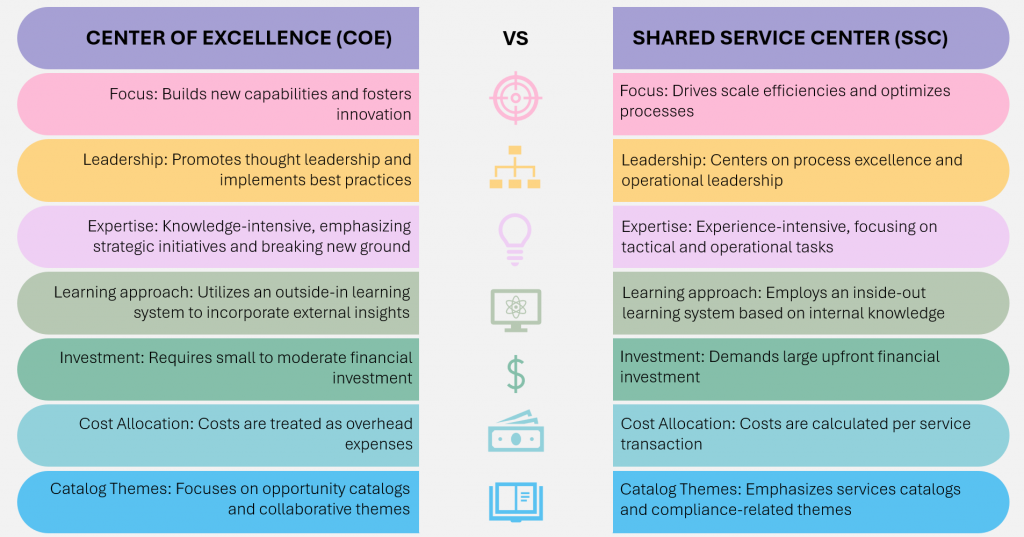Center of Excellence vs Shared Service Center: A Strategic Comparison
Aligning operational structures with business objectives drives efficiency and innovation. Choosing the right model enhances organizational capabilities, optimises costs and strengthens strategic positioning. For long-term value creation, read on to know the key differences and benefits between CoEs and SSCs.
Understanding Core Models
CoE Framework
A Centre of Excellence (CoE) consolidated subject matter expertise, technological innovation and standardisation of processes. It operates as a hub for specialised knowledge, driving best practices across the organisation. By centralising talent and resources, a CoE enhances quality and ensures continuous improvement in critical functions.
SSC Structure
A Shared Service Center (SSC) consolidates routine operational tasks to drive efficiency and cost savings. Focused on transactional processes, SSCs leverage economies of scale to streamline workflows. This structure enhances operational consistency, reduces redundancies and supports scalable growth.
Key Differences
When choosing between a Center of Excellence and a Shared Service Center, it’s essential to understand their distinct roles. A CoE focuses on innovation, expertise and strategic development, while an SSC prioritizes efficiency, cost savings and operational excellence.
The following comparison highlights the key differences between these two models to help you determine the best fit for your business needs.

Also read: Center of excellence vs outsourcing
Strategic Value
Each structure delivers distinct advantages in impact, cost management and feasibility of implementation. Here’s how leaders can ensure that the model aligns with their organizational priorities:
Business Impact
A CoE enhances strategic decision-making and innovation, fostering long-term value. An SSC streamlines operations, improving efficiency and resource utilisation. The choice depends on business goals and functional priorities.
Center of excellence (CoE)
- Enhances problem-solving and accelerates R&D
- Supports digital transformation and technology adoption
- Drives innovation through specialised expertise
- Encourages collaboration across business units
- Strengthens competitive positioning in the industry
Shared Service Center (SSC)
- Improves workflow efficiency and reduces redundancies
- Ensures operational accuracy and compliance
- Enables significant cost savings through process optimisation
- Centralises service delivery for better scalability
- Enhances service consistency across global operations
Decision Factors
- Businesses focused on innovation benefit from CoEs
- SSCs are ideal for those prioritising operational efficiency
- Hybrid models leverage both innovation and cost control
Cost Considerations
SSCs reduce operational costs through centralisation and automation. CoEs require investment in expertise and technology but deliver high-value outcomes. Understanding financial implications ensures cost-effective decision-making.
SSCs
- Minimise costs through shared infrastructure and standardised processes
- Reduce overhead expenses by consolidating functions
- Leverage automation for lower operational costs
- Improve resource utilisation through economies of scale
CoEs
- Require upfront investment but drive high returns through expertise
- Foster revenue growth through innovation-driven solutions
- Enable long-term cost savings by reducing inefficiencies
- Enhance business resilience with a focus on strategic initiatives
Balance
- Budget constraints influence the choice of model
- Long-term value expectations determine financial feasibility
- Businesses must weigh short-term savings against long-term benefits
Implementation Requirements
Deploying a CoE involves knowledge capital, governance frameworks and technology integration. SSCs demand process standardisation, automation tools and robust service delivery models. Aligning implementation with business needs drives success.
CoE Setup
- Requires talent acquisition and training investments
- Involves R&D investments and innovation-driven culture
- Needs strong leadership buy-in and strategic alignment
- Demands integration of cutting-edge technologies
- Requires performance metrics to measure success
SSC Setup
- Needs process automation and digital workflow solutions
- Demands structured workforce management
- Requires compliance frameworks and risk management
- Involves seamless coordination between global teams
- Ensures service level agreements (SLAs) for operational excellence
Implementation Complexity
- CoEs require long-term planning with phased execution
- SSCs offer quicker deployment with immediate cost benefits
- Hybrid approaches balance complexity with flexibility
Making the Right Choice
Evaluating business objectives, operational needs, and future scalability helps ensure the right model is selected.
Assessment Criteria
When choosing between the two models, key evaluation factors include business strategy, process complexity and expected outcomes. Furthermore, understanding operational priorities enables alignment with organisational goals.
Strategic Fit- Check if the model
- Aligns with your long-term business objectives
- Supports your technological innovation and digital transformation goals, efficiency or a hybrid approach
- Enhances organisational agility and market responsiveness
Operational Needs – Before choosing a specific model,
- Determine if the organizational processes require standardisation or high expertise
- Identify key functions that drive competitive advantage, and check if they require support
- Evaluate technology and automation readiness at an organizational level
Investment vs ROI – When evaluating the bottom line,
- Compare financial efficiency and operational returns
- Consider the time-to-value for cost efficiency and innovation
- Assess the overall sustainability of the chosen operational model
Organisational Fit
A CoE is ideal for businesses focusing on expertise and innovation. SSCs suit companies seeking efficiency and cost optimisation. Choosing the right fit maximises long-term benefits.
CoE Fit
- Best for R&D-driven, innovation-led industries
- Suitable for organisations requiring specialised skills
- Ideal for companies looking to lead in digital transformation
SSC Fit
- Suitable for cost-sensitive, process-oriented businesses
- Best for enterprises seeking high operational efficiency
- Works well in industries with repetitive, standardised functions
Hybrid Approach
- Combines expertise-driven innovation with efficiency
- Offers flexibility for evolving business needs
- Optimises both cost control and strategic growth
Future Scalability
As businesses evolve, flexibility in operational models becomes crucial. CoEs support knowledge expansion, while SSCs enable process scalability. Future-proofing decisions ensure sustainable growth and agility.
CoE Growth
- Supports continuous improvement and industry leadership
- Drives thought leadership and market differentiation
- Strengthens intellectual capital for long-term competitiveness
SSC Expansion
- Easily adaptable to increased service demands
- Enables rapid scaling of shared resources
- Integrates seamlessly with global business operations
Scalability Strategy
- Businesses must assess long-term adaptability of chosen models
- Hybrid approaches ensure flexibility across changing market conditions
- Digital transformation enhances scalability of both models
The framework for an ideal operation is one that brings strategic expertise with efficient service delivery. The ability of Centres of Excellence together with the efficiency of Shared Service Centres allows the organisations to innovate and optimise costs, creating structure for a resilient platform for future scalable growth and sustainable advancement.
One exemplary illustration of this approach was one taken by a home improvement retailer. When Lowe’s decided to transform its operational strategy, ANSR created a hybrid model that included the innovation focus of a Centre of Excellence and the process efficiency of a Shared Service Centre.
With this innovative approach, it moved from an initial team of 50 to well over 4,300 talented individuals without compromising process efficiency and enhancing product quality. A well-balanced operational model can thus lead to tangible business benefits and sustain competitive advantage in a dynamic marketplace.
In transforming operations, there is a need for more than just expert consulting. ANSR designs custom solutions within your business objectives to ensure all aspects of your operation performance are optimised. Talk to ANSR today about transforming your operational strategy into a competitive advantage and building an agile as well as an effective infrastructure.




